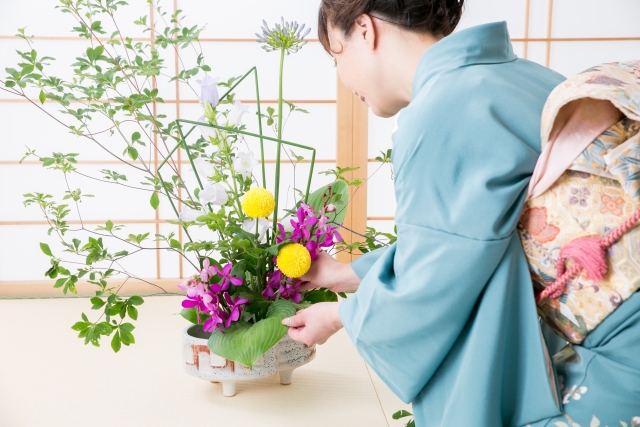Ikebana, the Japanese art of flower arrangement, is much more than simply placing flowers in a vase. It is a disciplined art form where nature and humanity are brought together, creating a harmony that speaks to the soul. Unlike Western floral arrangements that often emphasize abundance and symmetry, ikebana celebrates minimalism, balance, and the beauty of negative space. This ancient practice has evolved over centuries but remains deeply connected to Japanese philosophy and aesthetics, offering not just visual beauty but also a path to mindfulness and inner peace.
Ikebana literally translates to “making flowers alive” or “giving life to flowers,” reflecting the profound respect for nature at its core. Whether you’re curious about trying this art form yourself or simply want to understand its cultural significance, this guide will walk you through everything you need to know about the fascinating world of Japanese flower arrangement.
History and Origins of Ikebana
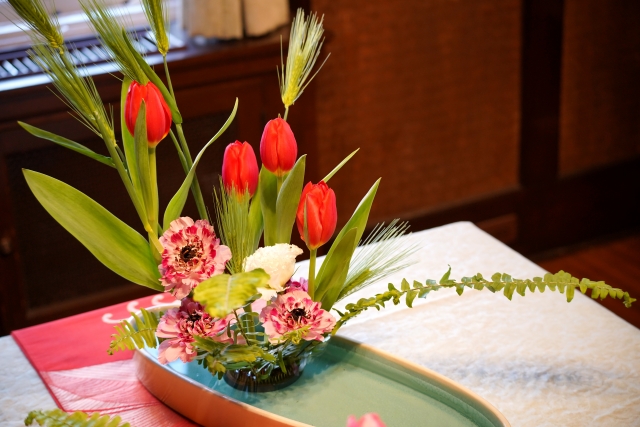
The roots of ikebana can be traced back to the 6th century when Buddhism arrived in Japan from China and Korea. Initially, flowers were offered at altars and temples as religious offerings. These early arrangements were called “tatebana” and would later evolve into what we now know as ikebana.
The formal art of ikebana truly flourished during the 15th century, particularly under the influence of Ashikaga Yoshimasa (1436-1490), the eighth shogun and a great patron of the arts. Yoshimasa developed important concepts that would form the foundation of ikebana’s rules, including the principle that flowers offered ceremonially should be thoughtfully arranged rather than simply gathered.
During this period, the celebrated painter Sōami conceived the idea of representing three elements in flower arrangements:
- Heaven (shin)
- Earth (soe)
- Humanity (tai)
This three-point structure became fundamental to ikebana philosophy and remains influential today.
By the 16th century, ikebana had branched into two major styles:
- Rikka – a formal, decorative style
- Nageirebana – a simpler, more naturalistic approach
Over time, numerous schools developed, each with their own interpretations and techniques, but all sharing core principles rooted in Japanese aesthetics and philosophy.
Basic Principles and Philosophy of Ikebana
Ikebana is governed by several key principles that distinguish it from other floral art forms:
The Three Main Rules of Ikebana
- Asymmetry and Balance: Unlike Western arrangements that often prioritize symmetry, ikebana embraces asymmetrical balance. This reflects the natural world, where perfect symmetry is rare.
- Minimalism: Each element in an ikebana arrangement is carefully chosen, with an emphasis on “less is more.” Most arrangements include only 5-13 stems, creating focus on individual elements rather than overwhelming abundance.
- The Triangle Principle: Most traditional ikebana creates a scalene triangle, symbolizing the harmony between heaven, earth, and humanity. The tallest element (shin) represents heaven, the middle (soe) represents humanity, and the lowest (tai) represents earth.
Beyond these structural rules, ikebana embodies several philosophical concepts:
- Wabi-sabi: Finding beauty in imperfection and impermanence
- Ma: The importance of negative space between elements
- Seasonality: Celebrating the current season through appropriate plant materials
- Mindfulness: The practice of ikebana as a form of meditation
As Holly Carlisle, a floral artist and founder of ROSEGOLDEN Design Studio, explains: “Acknowledging and appreciating seasonal changes is fundamental to ikebana.” This connection to the natural world and its cycles is at the heart of ikebana practice.
Major Schools of Ikebana
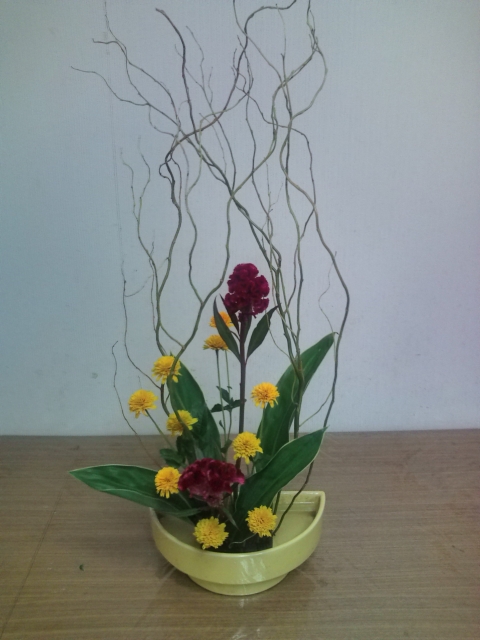
Over centuries, numerous ikebana schools have developed, each with their distinctive approach. Here are some of the most influential:
Ikenobo
The oldest and most traditional school, Ikenobo traces its origins to the 8th century and the construction of the Rokkaku-dō temple in Kyoto. Ikenobo is known for its classic rikka style and shoka style, both of which adhere closely to traditional principles and rules.
Sogetsu
Founded in 1927, Sogetsu embraces a more contemporary approach, encouraging creative freedom while respecting fundamental principles. Their philosophy is that ikebana can be created by anyone, anywhere, using any materials. This school has helped popularize ikebana internationally.
Ohara
Established in the late 19th century, the Ohara School introduced the moribana style, characterized by arrangements in low, shallow containers using a kenzan (metal flower frog). This school beautifully bridges traditional techniques with modern sensibilities.
Modern and Freestyle Ikebana
Contemporary practitioners often blend traditional techniques with personal expression, creating arrangements that respect ikebana’s core principles while exploring new forms and materials. The “Nageire” style, which means “to throw in,” represents one of the freest approaches to ikebana, focusing on the natural form of flowers.
Essential Tools and Materials
To practice ikebana, you’ll need several key items:
Containers (Utsuwa)
Unlike Western flower arrangements that often use tall, opaque vases, ikebana uses a variety of vessels:
- Shallow bowls (moribana style)
- Tall, narrow vases (nageire style)
- Baskets
- Ceramic vessels
The container is considered an integral part of the arrangement, not just a holder for flowers.
Kenzan (Flower Frog)
A kenzan is a heavy metal pin holder used to secure stems in place. It’s typically placed at the bottom of a shallow container and holds stems upright through its sharp pins.
Hasami (Flower Scissors)
Special scissors designed for cutting stems cleanly are essential. These are typically sharper and more precise than regular scissors.
Plant Materials
Ikebana uses a wide range of materials:
| Material Type | Examples | Symbolic Meaning |
|---|---|---|
| Branches | Pine, bamboo, cherry | Strength, flexibility, renewal |
| Flowers | Chrysanthemum, lotus, iris | Seasonal beauty, purity, grace |
| Leaves | Aspidistra, fern, magnolia | Texture, foundation, contrast |
| Grasses | Pampas grass, bear grass | Movement, simplicity, wildness |
| Unconventional | Fruits, stones, dried elements | Creativity, unexpected beauty |
When selecting materials, consider not just the blooms but also the line, form, and texture of stems, leaves, and branches.
How to Create a Basic Ikebana Arrangement
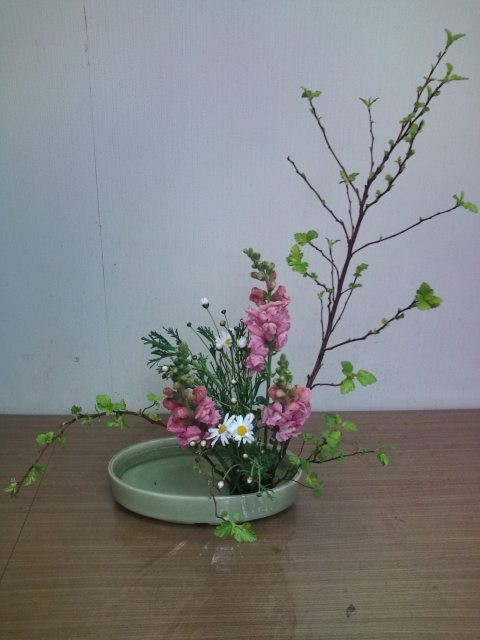
Here’s a step-by-step guide to creating a simple ikebana arrangement in the moribana style (using a shallow container):
- Prepare your materials:
- Fill your container with fresh water
- Place your kenzan securely in the container
- Gather your plant materials and trim as needed
- Have a towel and scissors ready
- Place your primary stem (shin):
- Select a strong, tall branch or stem
- Cut the stem at an angle for better water absorption
- Position it vertically or at a slight angle (about 10-15 degrees)
- The height should be approximately 1.5 times the width of the container
- Add the secondary stem (soe):
- Choose a stem slightly shorter than the shin
- Position it at about a 45-degree angle to the left
- Its height should be about 3/4 of the shin’s height
- Insert the tertiary stem (tai):
- Select a shorter, fuller element
- Position it at the front, lower than the other two
- This creates the base of the triangular structure
- Add accent elements if desired:
- Small flowers, leaves, or grasses can fill spaces
- Use these sparingly to maintain the minimalist aesthetic
- Each addition should have purpose and enhance the overall composition
- Step back and observe:
- View your arrangement from different angles
- Look for balance and harmony
- Make adjustments as needed
Remember that ikebana is as much about the process as the result. Take your time, observe the materials, and let intuition guide your choices.
Styles and Techniques
Ikebana encompasses several major styles, each with unique characteristics:
Rikka (Standing Flowers)
Developed in the 15th century, rikka uses seven main branches to represent different aspects of nature, creating elaborate, formal arrangements. This is one of the oldest and most structured styles, traditionally used for ceremonial occasions.
Shoka (Living Flowers)
Shoka emerged in the 17th century as a simplified alternative to rikka. It uses three main branches (shin, soe, tai) to create a harmonious, naturalistic composition that captures the essence of plants in their natural environment.
Moribana (Piled-up Flowers)
Created in the late 19th century, moribana arrangements use shallow containers with a kenzan. This versatile style allows for greater creativity while maintaining traditional principles.
Nageire (Thrown-in Flowers)
Nageire uses tall vases without a kenzan, relying instead on the vase’s neck to support stems. This style has a more casual, spontaneous feeling and greater emphasis on natural form.
Free Style
Contemporary ikebana often incorporates elements from various traditional styles while allowing for personal expression and unconventional materials. As one practitioner notes, “People should feel free to approach ikebana-inspired floral arrangements in their own way.”
Seasonal Considerations
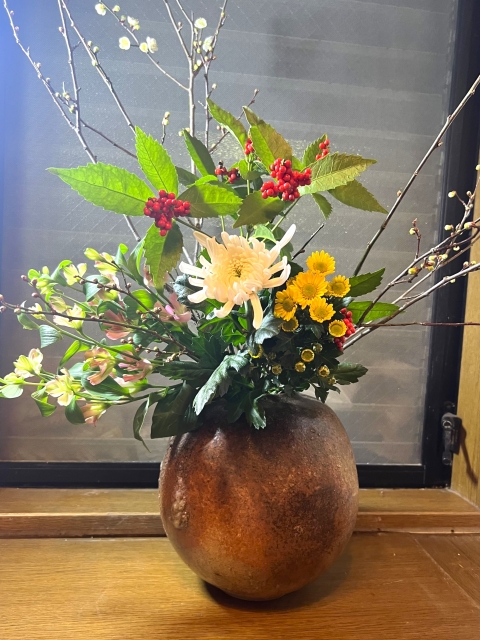
Seasonality is central to ikebana. Traditional Japanese culture highly values the changing of seasons, and ikebana celebrates these transitions through appropriate plant selections:
Spring
Spring arrangements often feature cherry blossoms, plum branches, daffodils, and early blooming flowers to represent renewal and awakening.
Summer
Summer calls for vibrant materials like irises, hydrangeas, and lush greenery, expressing the season’s vitality and abundance.
Autumn
Fall arrangements incorporate chrysanthemums, maple branches with colored leaves, and berries to capture the richness and transformation of autumn.
Winter
Winter ikebana emphasizes evergreens, bare branches, and hardy plants like camellias, representing endurance and finding beauty in simplicity.
By working with seasonal materials, ikebana practitioners connect to the natural cycles and rhythms of the world around them, creating arrangements that feel timely and meaningful.
Incorporating Ikebana in Modern Life
In today’s busy world, ikebana offers a compelling counterpoint to fast-paced modern living:
Home Décor
Ikebana brings nature’s beauty indoors in a mindful, intentional way. Unlike lavish flower arrangements that might overwhelm a space, ikebana creates focal points that enhance rather than dominate their surroundings.
Mindfulness Practice
Creating ikebana can serve as a form of moving meditation. The focused attention required helps quiet the mind and brings awareness to the present moment—a valuable respite from digital distractions.
Environmental Consciousness
The minimalist nature of ikebana means using fewer flowers than Western-style arrangements, making it an environmentally friendly choice. It also encourages appreciation for local, seasonal materials.
Cross-Cultural Connection
As interest in Japanese aesthetics grows globally, ikebana provides a hands-on way to experience Japanese cultural values and philosophy.
Many cities around the world now offer ikebana classes, and various schools have international branches where beginners can learn from qualified instructors.
Conclusion
Ikebana represents far more than flower arrangement—it embodies a philosophy, an aesthetic, and a way of seeing the world. Through its careful balance of form and space, tradition and innovation, ikebana continues to offer beauty and meaning to those who practice and appreciate it.
Whether you’re drawn to ikebana for its visual appeal, its cultural significance, or its meditative qualities, there’s never been a better time to explore this ancient art. By starting with simple arrangements and basic principles, anyone can begin to experience the unique satisfaction of creating something that honors nature’s beauty while expressing human creativity.
In a world that often values excess and speed, ikebana reminds us of the power of simplicity, patience, and attentiveness—qualities that enhance not just our floral arrangements but our lives as well.
